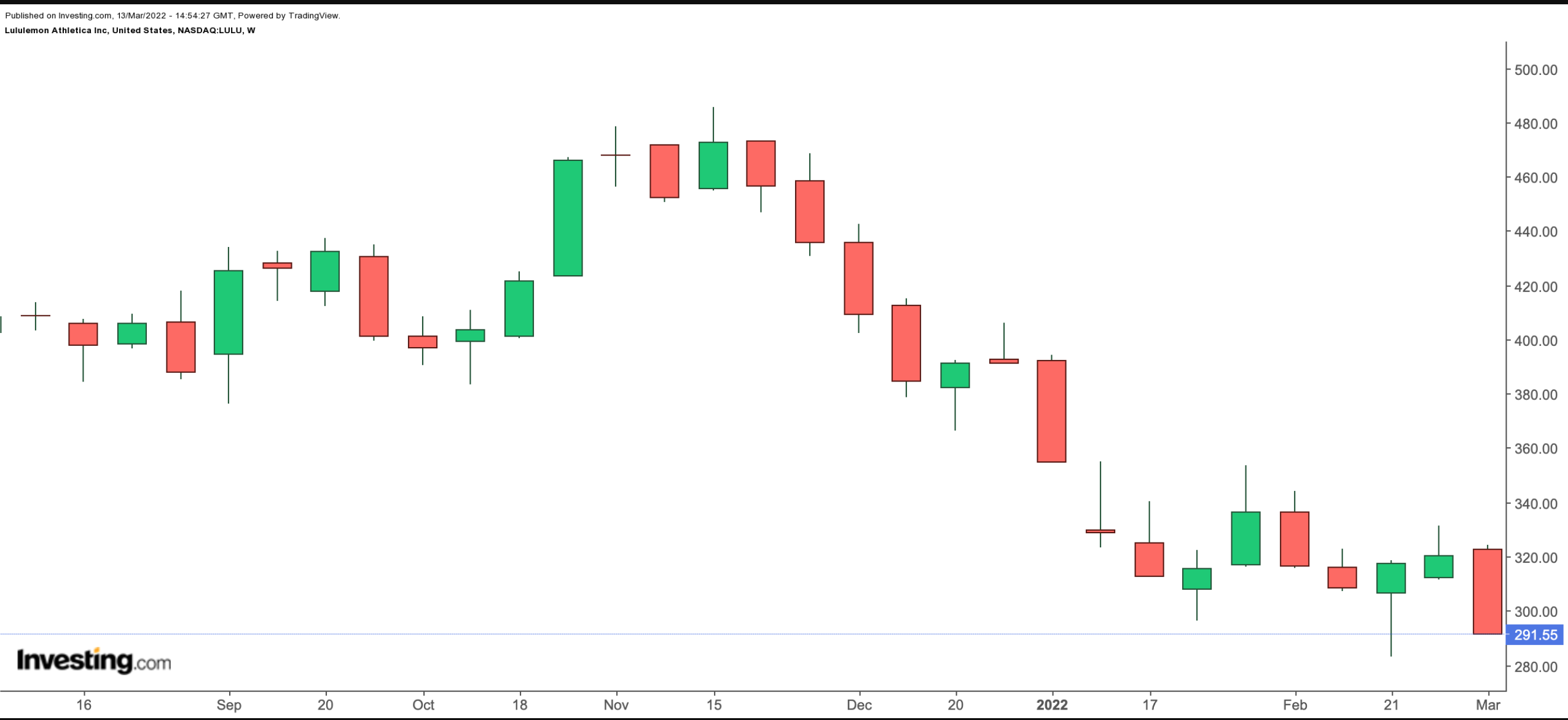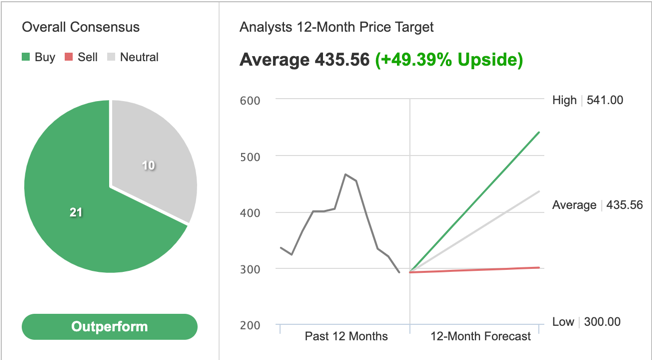- Athletic apparel group Lululemon Athletica shares have lost over 25% since the beginning of 2022
- In January, management revised down the Q4 EPS guidance
- Long-term investors could consider buying LULU stock at current levels
Shares of the athletic apparel retailer Lululemon Athletica (NASDAQ:LULU) are down 25.5% so far this year, and 4.7% in the past 12 months. By comparison, the Dow Jones Retailers Index is up 0.1% (or flat) year-to-date (YTD), but down 15.3% in the past year.

Meanwhile, since January, shares of Nike (NYSE:NKE) and Under Armour (NYSE:UA), two athletic apparel competitors, have lost 26.4% and 22.4%, respectively.
On Nov. 16, LULU shares went over $485 to hit a record high. But since then, they have come under significant pressure. The stock’s 52-week range has been $283.21-$485.82, while the market capitalization (cap) stands at $36.2 billion.
Founded in 1998 in Canada, Lululemon initially became known for its upscale yoga wear. Then the apparel name went public in July 2007.
The athleisure brand has recently announced its entry into footwear. Besides, management has also brought Mike Aragon, former Chief Content Officer of Amazon-owned, Twitch, to head its in-home digital fitness platform MIRROR, an at-home fitness company with an interactive workout platform featuring live and on-demand classes
Lululemon bought MIRROR for $500 million in 2020 but earlier this year, Nike filed a lawsuit against LULU for patent infringement over Mirror Home Gym.
Recent Metrics
Lululemon released Q3 financials on Dec. 9. For financial reporting purposes, its fiscal year ends on Jan. 30.
Revenue was $1.5 billion, up 30% year-over-year. While comparable store sales increased 32%, direct-to-consumer net revenue went up by 23%.
Lululemon opened 18 new company-operated stores, ending the quarter with 552 stores. Adjusted earnings per share were $1.62, compared with $1.16 a year ago.
On the results, chief financial officer Meghan Frank commented:
"We are pleased with these results given the ongoing, industry-wide supply chain issues we continue to navigate. While there are several large volume weeks ahead of us, we feel well positioned for a strong end to 2021.”
Following the Q3 results, management shared its Q4 outlook. Accordingly, the quarterly revenue was forecast to come in between $2.125 billion and $2.165 billion. Adjusted diluted EPS was expected to come between $3.25 and $3.32.
However, on Jan.10, the company issued an updated forecast. CEO Calvin McDonald cited:
“We started the holiday season in a strong position but have since experienced several consequences of the Omicron variant, including increased capacity constraints, more limited staff availability, and reduced operating hours in certain locations.”
Hence, the apparel group now expects Q4 revenue and adjusted diluted EPS to be at the lower end of the aforementioned ranges.
Prior to the release of the quarterly results, Lululemon stock was around $425. But on Mar. 11, it closed at $291.55, a 30% slide.
What To Expect From Lululemon Athletica Stock
Among 31 analysts polled via Investing.com, LULU stock has an "outperform" rating.

Source: Investing.com
Wall Street also has a 12-month median price target of $435.56 for the stock, implying an increase of almost 50% from current levels. The 12-month price range currently stands between $300 and $541.
However, according to a number of valuation models, including P/E or P/S multiples or terminal values, the average fair value for LULU stock on InvestingPro stands at $324.72.
In other words, fundamental valuation suggests shares could increase about 11%.
We can also look at LULU’s financial health as determined by ranking more than 100 factors against peers in the consumer discretionary sector.
For instance, in terms of cash flow, growth and profit, it scores 4 out of 5. Its overall score of also 4 points is a good performance ranking.
At present, LULU’s P/E, P/B, and P/S ratios are 43.3x, 14.2x, and 6.4x. Comparable metrics for peers stand at 15.3x, 3.1x, and 1.6x. These numbers show that, despite the recent decline in price, the fundamental valuation for LULU stock is still on the rich side.
Meanwhile, those metrics for Nike are 31.4x, 13.0x, and 4.2x. And they stand at 19.4x, 3.3x, and 1.2x for Under Armour.
Our expectation is for LULU stock to build a base between $275 and $300 in the coming weeks. Afterwards, shares could potentially start a new leg up.
Adding LULU Stock To Portfolios
Lululemon bulls who are not concerned about short-term volatility could consider investing now. Their target price would be $435.56, analysts’ forecast.
Alternatively, investors could consider buying an exchange-traded fund (ETF) that has LULU stock as a holding. Examples include:
- Global X Health & Wellness ETF (NASDAQ:BFIT)
- Emles @Home ETF (NYSE:LIV)
- VanEck Retail ETF (NASDAQ:RTH)
- Global X Millennials Consumer ETF (NASDAQ:MILN)
- iShares Evolved U.S. Discretionary Spending ETF (NYSE:IEDI)
Finally, investors who expect LULU stock to bounce back in the weeks ahead could consider setting up a bull call spread.
Most option strategies are not suitable for all retail investors. Therefore, the following discussion on LULU stock is offered for educational purposes and not as an actual strategy to be followed by the average retail investor.
Bull Call Spread On Lululemon Athletica Stock
Current Price: $291.55
In a bull call spread, a trader has a long call with a lower strike price and a short call with a higher strike price. Both legs of the trade have the same underlying stock (i.e., LULU) and the same expiration date.
The trader wants LULU stock to increase in price. In a bull call spread, both the potential profit and the potential loss levels are limited. The trade is established for a net cost (or net debit), which represents the maximum loss.
Today’s bull call spread trade involves buying the June 17 expiry 300 strike call for $26.40 and selling the 310 strike call for $22.30.
Buying this call spread costs the investor around $4.10, or $410 per contract, which is also the maximum risk for this trade.
We should note that the trader could easily lose this amount if the position is held to expiry and both legs expire worthless, i.e., if the LULU stock price at expiration is below the strike price of the long call (or $300 in our example).
To calculate the maximum potential gain, we can subtract the premium paid from the spread between the two strikes, and multiply the result by 100. In other words: ($10 – $4.10) x 100 = $590.
The trader will realize this maximum profit if the LULU stock price is at or above the strike price of the short call (higher strike) at expiration (or $310 in our example).
Bottom Line
Since mid-November, LULU stock has come under significant pressure. Yet, the decline has improved the margin of safety for buy-and-hold investors who could consider investing soon. Alternatively, experienced traders could also set up an options trade to benefit from a potential run-up in the price of LULU stock.
